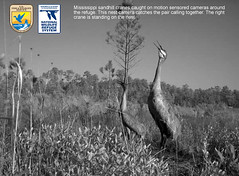 Image by USFWS/Southeast via FlickrBy Matthew Jorn
Image by USFWS/Southeast via FlickrBy Matthew JornSandhill Cranes are among the most spectacular of the bird families, in fact, they have captured the human imagination as few other birds have. Famed naturalist and pioneering wildlife biologist Aldo Leopold described them as, "nobility in the midst of mediocrity." There are 15 species of cranes in the world, found on all continents except South America and Antarctica. Besides being one of the most interesting bird families, cranes are among the most endangered.
The Mississippi Sandhill Crane was described as a distinct subspecies in 1972 and there are physiological, morphological, behavioral and other differences between them and other Sandhill Cranes. The MS Crane at maturity have a 6-8 feet wingspan which helps them glide effortlessly through the air. Spending hours in the air utilizing thermal winds to conserve energy, they only need to occasionally flap their wings. They are a noticeably darker shade of gray giving them a more distinct cheek patch.
Despite the limited number of breeding pairs in the wild, electrophoretic studies indicate a high level of genetic diversity. These studies also show that the MS Sandhill Cranes have one gene that is unique to Sandhills and another that is different from even the Florida Sandhill Crane.
Mississippi Sandhill cranes are found in habitats bordering the Mississippi Sandhill Crane National Wildlife Refuge, and no where else on Earth. There are only about 110 individuals remaining, including about 20-25 breeding pairs. The primary reason for their decline is loss of habitat. The original range of this population was thought to extend along the Gulf coastal plain from southern Louisiana east into Mississippi, Alabama, and into the western Florida panhandle. The last known breeding records in Louisiana are from the 1910's and Alabama from 1960.
Much of the loss of crane habitat is due to the conversion of open pine savanna to pine plantations created following World War II. The Mississippi and Florida Sandhill Cranes were listed as rare in the 1968 list of Rare and Endangered Wildlife of the United States. After being described as a separate subspecies, the Mississippi Sandhill Cranes were added to the United States' List of Endangered Fish and Wildlife in 1973.
The Recovery Plan is a year-round program that enlists biologists to track, document, band, and aid the cranes in mating. In the Winter the cranes are trapped and their bands are repaired or replaced and documentation on the cranes are taken. During the Spring biologists track and observe the nests of the cranes as well as test the viability of their eggs. Monitoring the incubation and number of chicks that hatch is also part of the equation. The MS Sandhill Crane became the first bird to have a young hatched where an egg was fertilized by a sperm that was previously thawed out from a cryogenic state. This occurred at the Audubon Institute as part of this subspecies' Recovery Plan.
With air conditioning, rising living standards, and interstate construction, thousands of people moved to the Mississippi Gulf Coast to live and visit. The habitat was divided and subdivided until the refuge is now only small islands surrounded by human-altered landscapes. Cranes have also been directly harassed, shot, and suffered the effects of oil spills. With the efforts of the Recovery Plan and the Mississippi Sandhill Crane, hopefully these creatures can be preserved and eventually repopulate their home.
This article was written by Matthew Jorn is part of a series of entries highlighting the cultural, natural, and sociological virtues of Coastal Mississippi. Shopping for a Ford Explorer Gulfport shoppers know they can trust Mr. Ford Gulfport Ford Dealerships.
Article Source: http://EzineArticles.com/?expert=Matthew_Jorn
http://EzineArticles.com/?Endangered-Mississippi-Sandhill-Crane&id=4763036

No comments:
Post a Comment